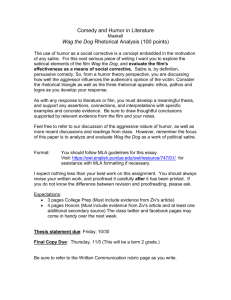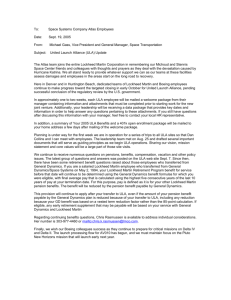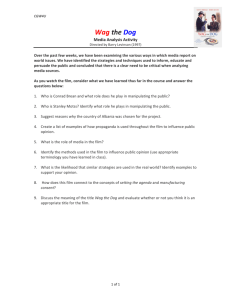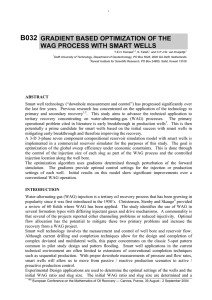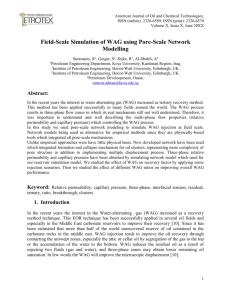Ula Field Miscible WAG Flood Assessment by Simon
advertisement
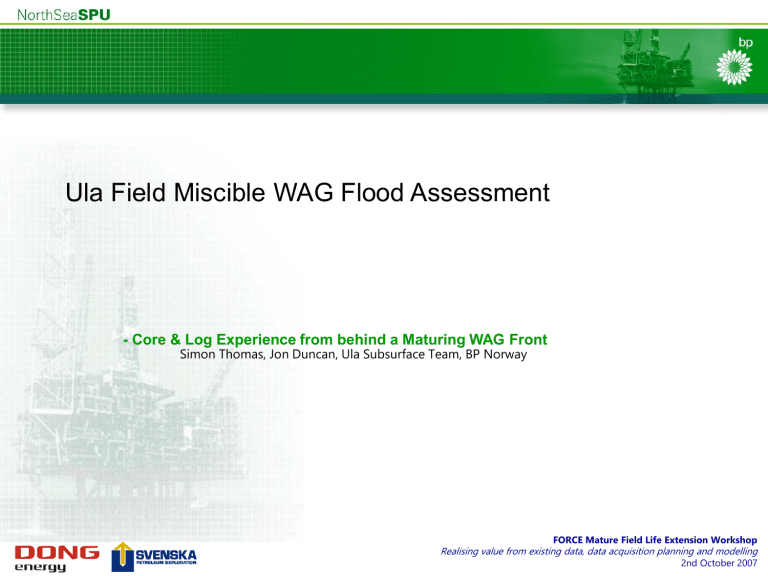
Ula Field Miscible WAG Flood Assessment - Core & Log Experience from behind a Maturing WAG Front Simon Thomas, Jon Duncan, Ula Subsurface Team, BP Norway FORCE Mature Field Life Extension Workshop Realising value from existing data, data acquisition planning and modelling 2nd October 2007 Ula Field Introduction Discovered: 1976; First Oil: 1986 Water depth 67m 100m thick shallow marine reservoir ULA Moderately deep and hot Depth: 3350-3800mtvdss Temperature: 150ºC Volumes: In-place: ~1 billion barrels Produced: ~ 420 million barrels Late field-life initiatives: Infill drilling Unit 1 horizontal wells Drilling Living Q Production Ula Field Reservoir Ula Sandstone Stratigraphy Depositional Environment Reservoir Layering Bioturbated fine-medium grained sandstone with nodular calcite cement stringers Depositional Setting: Storm dominated shallow marine shelf Upper Jurassic Ula Sst Member (Farsund Fm) Retrogradational Shelf Unit 1 Progradational Shelf Unit 2A1-2 Progradational Shelf Unit 2A3-6 Aggradational Shelf Unit 2B Progradational Shelf Unit 3A-B Ula Field Producing Wells 8 Crestal Oil Producers 3xUnit 2-3 WAG 5xUnit 1 horizontal 7 Flank Injectors 3xUnit2-3 water injectors 4xUnit 2-3 WAG injectors Ula Field WAG Surveillence Wellhead P & T Monthly well Injection testing PLT’s Gas & Water Gas Injection Tracers Water Injection Tracers ULA 7/12-A-9A Logs & Core Pilot well for planned horizontal injector Drilling Living Q Production A15-A3A WAG Panel A-15 Oil Producer me: 7/12-A-15 ID: A15:7/12-A-15 Type: OIL Format: ula_prod_group (1)40.0 (3)50.0 20.0(2) 50000(4) 36.0 45.0 18.0 45000 32.0 40.0 16.0 40000 28kb/d 28.0 35.0 12.0 30000 10.0 25000 20kb/d 16.0 20.0 8.00 20000 12.0 15.0 6.00 15000 8kb/d 8.00 10.0 4.00 10000 1kb/d 4.00 5.00 0 0 87 88 89 90 (1)Oil Rate,MB/d 1989/1990 A15 & A3A Start-up 91 A-9A Observation Well 14.0 35000 24.0 30.0 20.0 25.0 1500m 92 93 94 (2)Gas Rate,MMCF/d VS Time 1994 A-15 Water Breakthrough 95 96 97 98 2.00 5000 99 (3)Water Rate,MB/d 1998 A-3A WAG Start-up 00 01 0 0 (4)OilCum_MB,MB 2000 A-15 WAG Oil Arrival Increased Oil rates & GOR (1-4kb/d) 500m A-3A WAG Inector Ula WAG Observation Well Objectives Is current Ula Field WAG working? Halted production decline & increasing GOR support pilot success Where and how big is the ultimate WAG prize? Recent SCAL data indicates high potential prize: Sorm 5% (Sorw 30%) & Sgt 35% How efficient is the WAG process? Which intervals of the reservoir are being contacted by the WAG injection? Fundamentally: Sorw, Sorm, Sg, kh & kv What do we do next? How do we optimally design the future WAG injector/producer drilling program to access to remaining oil in Ula? Data Acquisition Challenges Wireline Data Core Data complicated logging environment 3-phase fluid mobility system Deep Invasion Sample Invasion 3-phase mobility Coring & Plugging Gas Presence Sample Losses gas injection Gas-expansion drive Miscible gas injection process Mixed Waters formation & seawater Oil Properties Reservoir Cooling density, formation factor water injection Water Properties density (salinity) COST!! – Justified by the large size (>100mmbbl) but large uncertainty of the potential WAG prize Ula A9A Wireline Logging Program Baker Atlas Wireline Logging Contract Gamma-ray, density, neutron, sonic & laterolog resistivity 57 Pressures & 7 fluid samples Nuclear Magentic Resonance – Gas & Non-RT based saturation profiles Openhole Pulsed Neutron – Gas saturation profiles Carbon/Oxygen – Non RT based saturation profiles Electrical resistivity images – Small-scale heterogeneities Directional induction resistivity – fluid related anisotropy Ula A9A Coring Program Low invasion, high ROP coring system Low invasion water-based (NaCOOH) mud with Deuterium tracer Assumed that the dominant mobile fluid phase would be water Slow, staged tripping to avoid gas drive Assumed that both free gas and high GOR oil would be present Ula A9A Core Analysis & Program Core plugged offshore under oil & brine and onshore under nitrogen Multiple measurements including: Porosity, vertical, horizontal permeability & probe permeametry Dean & Stark Water & oil saturations Spun Water Resistivities - for calibrating Archie water saturation model Gas Chromatography Analysis – for determining degree of WAG contact Plug Sampling Program Plugged under oil at well site 20cm Dean-Stark Sw Centifuged Water D2O; Ø & k D2O; Rw Plugged with N2 gas in lab 15cm Dean & Stark Sw Ø&k Gas Chromatography Wrapped & waxed in laboratory 30cm CT Scanned 10 Samples selected Plugged whilst frozen 1vertical & 1 horizontal Plugged with Plugged under brine N2 gas in lab at well site 15cm Dean & Stark Sw Ø&k Gas Chromatography 20cm Dean & Stark So Centrifuged Oil Ø & k Gas Chromatography 100m of core; 800plugs & >2000 petrophysical measurements Reservoir Quality & Layering Unit 1 1 Unit 2A 2 Unit 2B 3 4 Unit 3A Reservoir Pressure 3 layer pressure system 2 key pressure barrier/baffles Pressure Unit 1A shale barrier (1200psi) Unit 2A6 baffle (40psi) Unit 1A Barrier 1200psi Calcite Calcite Depletion Unit 2A6 Baffle Calcite Calcite Calcite Unit 1A Barrier Producing from 1A & 2A with injection into Units 1A+2A+2B Oil & Water Saturation Profiles Offshore & onshore samples Oil, water & nitrogen cutting No gas or fluid loss Sw range between 40-60% 0-50% sample contamination Gas or fluid loss? So range between 10-70% 1.36 FVF used to covert from stocktank to reservoir conditions Minor Gas or fluid loss? Core So more robust than Sw Mobile water may have been lost In-situ So Sw from from logs used to check Preserved Core SCAL Sample So after Bumpflood Log-based Water Saturation Archie Model: Resistivity (@25C Ohmm) 0.000 3820.00 0.050 0.100 a.Rw Sw n m Ø .Rt 0.150 0.200 Rmf (Flowline) Centrifuged Data (<15% Invasion) Centrifuged Data (15-30% Invasion) Centrifuged Data (>30% Invasion) 3840.00 MDT Samples (~15% Invasion) MDT Sample (>15% Invasion) MDT Sample (60%+ Formate) Rw profiles determined from: Rmf Core #2 Rmf Core #3 100 spun-water samples from core wellhead produced water samples historical water resistivity data n-exponent determined from: 3860.00 Measured Depth (m) 2 downhole fluid samples Rmf Core #1 Adjust? 3880.00 20 oriented electrical plugs Adjust? 10.0 A9A Clean-up Water Native Horizontal 9.0 Native Vertical 3900.00 Post Bump Horizontal Zero Invasion Baseline Post Bump Vertical 8.0 Gas Desaturation Horizontal Gas Desaturation Vertical n exponent 7.0 6.0 At So >30% n exponents are typically ~2.3-2.6 AT So<30% n expoents rise rapidly tow ards values ~4 5.0 4.0 3920.00 Injection Water 3.0 2.0 A15 Produced Water Trend is similar for both vertical & horizontal plugs but exponenets are slightly higher w ithin vertical samples (see above) 1.0 0.0 0.0 10.0 20.0 30.0 40.0 1-Sw (% ) 50.0 60.0 70.0 80.0 Fluid Saturation Uncertainty Reduction Log Sw reconciles well with core based CSo & CSw Core-log comparison highlights: Intervals of remaining gas Intervals of lost core water Gas Core-log comparison does not illustrate WAG contact An independent method was required to assess gas contact Gas Gas Oil Composition Analysis Compositional oil analysis key to understanding WAG performance Original Oil Toluene extracted oil samples Gas chromatography analysis C50/Cn ratio analysis Identified compositional profiles Reduction in lighter end components unambiguously identifies WAG contact ’Stripped’ Oil Oil Composition Analysis Results CSw CSo Raw GC Dataset prior to normalisation. Note the correspondence between the low remaining oil saturations combined with gas indications and the reduced low carbon components. Normalised GC Dataset The upper <1A3 & lower >3B intervals are compositionally unchanged The 2A3-2A6 & 3A intervals appear to have minor compositional stripping The 1B-2A2 & 2B1-2B3 intervals have undergone extreme stripping Sector Modelling 2006: 1987: A-9A Permeability 2000: 2001: 2004: 2005: 1998: 1999: 2002: 2003: Initial 1997: 1989: 1990: 1991: 1993: 1994: 1995: 1996: Observation WAG WAG OilWater-flood Water-flood Saturation Injection Layering Injection Well Reservoir 1A 1B 2A 2B 3A 3B A-15 A-15 OP OP A-9A OBS A-3A INJ Summary Innovative integration of core & log data has been key to reducing saturation profile uncertainty fluid property profiles (resistivity & composition) are key descriptors Gas-flood has contacted only 40% of the reservoir within 2 layers Sorm’s reach down to 10-20%, consistent with SCAL Sorm’s Gas-flood by-passed intervals make up 60% of the reservoir Water-flood sweep has been variably effective Target intervals for future WAG confirmed with Sorw’s of 30-75% Acknowledgements BP Exploration & Production Technical Group (Sunbury, UK) ICCS (UK) & Reslab (Norway) Core Analysis Laboratories Baker Hughes (Wireline & Coring Operations) Andrew Spence (Independent Core Analysis Consultant) Questions or Comments?


